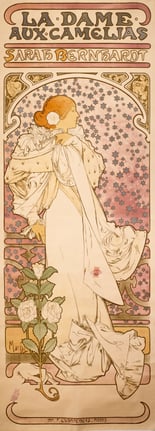The Culture Shock that was Art Nouveau
To understand Art Nouveau you first have to understand the ground it grew out of. The cultural and political shock of the French Revolution had left deep wounds throughout Europe and caused artists to resort to traditional art styles. In these traditions there was a familiarity, recognisability and in some sense a safety. With the advent of Gothic Revival, in England, and Neoclassical, Neo Renaissance and Neo Baroque styles emerging across Europe there was a clear demand for visual art that harkened back to past eras.

Art Nouveau was wholly different. The choice to turn away from historicism represented a paradigm shift of moving into a modern world that needed a modern art. With an increasingly affluent urban bourgeoisie, who had a growing interest in the arts, there was a call for new art that placed less importance on cultural past. Traditional art had served an aristocratic elite that had excluded may of those who were now gaining an interest in the arts and those people wanted art that reflected their world and the world they saw coming.
Art for the New World

This connection between the new affluent urban population, and a want for a new reflective art, found its feet in the ethos of the Arts and Crafts movement. Walter Crane, English artist and illustrator, talked of turning artists into craftsmen and craftsmen into artists and this coupled with a Gesamtkunstwerkian view of “total art” birthed Art Nouveau. In what would later become an unofficial manifesto for Art Nouveau, Henry Van de Velde wrote a pamphlet called Deblaiment d’Art (literally a ‘clearing of art’) that made the case for parity of esteem among all the arts, whether fine or applied.
Fine arts, like painting and sculpture, had enjoyed an elevated status for hundreds of years. With this new attitude toward design suggesting that the opportunity for art was all around us, art could be re-imagined in everyday objects. Decorative arts like ceramics and furniture were no longer to be seen as inferior to paintings and sculptures, and this was to extend further than the home. Advertising and public buildings could also be spaces for art and this form of art was directly relating to the boom in urban populations and consumerism.
An Oasis in Modernity
For Art Nouveau, to be modern in its day was synonymous with it being urban. The late 1800s and early 1900s, when the style flourished, was the point at which migration to cities and towns had tipped urban populations over the halfway point. For the first time in history, the majority of men and women were experiencing nature as an amenity. No longer was nature something to be grappled with but instead it was provided by the state as a form of relaxation or leisure with things like parks and gardens.
Recognising this need for nature in people’s lives, Art Nouveau artists and designers made it a theme in some form or another throughout the style. Flowers, leaves, blossom and many other natural symbols can be found throughout the many forms of Art Nouveau design. In places where the nature is not so obvious it is often represented by the flow or shape of the design. This is often seen in the architecture of Art Nouveau buildings.
 Legacy
Legacy
Art Nouveau’s reign was not long lived but this does not diminish its value to the history of art and design. Art Nouveau bequeathed something very important to modern art: a belief in modernity. Many of the great Modernist designers, like LeCorbusier or Gropius, accepted the central tenant of Art Nouveau thought, which was that the total environment should be considered. Art and design is not just to be looked at, it can be where people live and work. There is no reason that adverts couldn’t be beautiful and treated as art and equally no reason that an underground station could not have the same level of design as a great sculpture.
This post is based off extracts from our book Art Nouveau (ISBN: 9781786647849). This title is part of our Masterpieces of Art series which is packed, with tonnes of information and beautiful images. You can order it from our website here or on Amazon here.
Check out all of the MoA blog posts from 2018!
- Masterpieces of Art | 1 | John Signer Sargent
- MasterPieces of Art | 2 | Art Nouveau
- Masterpieces of Art | 3 | Egon Schiele
- Masterpieces of Art | 4 | Art Deco
- Masterpieces of Art | 5 | Heath Robinson
- Masterpieces of Art | 6 | Paul Gaugin
- Masterpieces of Art | 7 | Frida Kahlo
- Masterpieces of Art | 8 | William Blake



